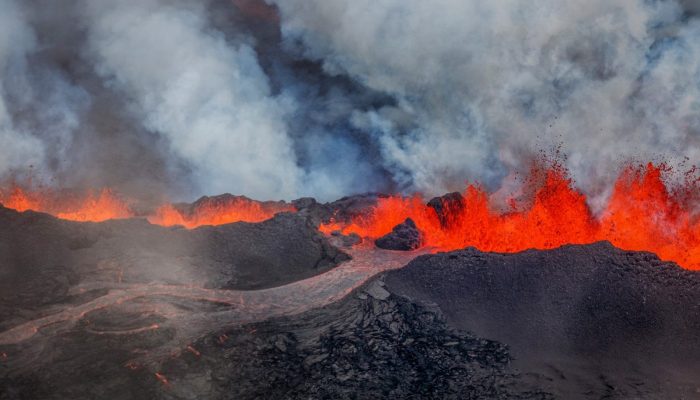
Have you ever thought of using gelatin in the lab to simulate the brittle-elastic properties of the Earth’s crust? Stefano Urbani, PhD student at the university Roma Tre (Italy), uses it for his analogue experiments, in which he studies the controlling factors on dike propagation in the Earth’s crust. Although we share this topic with our sister division ‘Geochemistry, Mineralogy, Petrology & Volcanology (GMPV)’, we invited Stefano to contribute this post to ‘Minds over Methods’, in order to show you one of the many possibilities of analogue modelling. Enjoy!
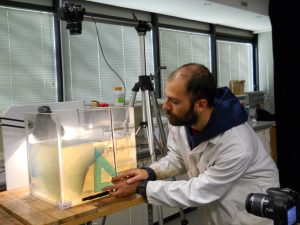 Using analogue models and field observations to study the controlling factors for dike propagation
Using analogue models and field observations to study the controlling factors for dike propagation
Stefano Urbani, PhD student at Roma Tre University
The most efficient mechanism of magma transport in the cold lithosphere is flow through fractures in the elastic-brittle host rock. These fractures, or dikes, are commonly addressed as “sheet-like” intrusions as their thickness-length aspect ratio is in the range of 10-2 and 10-4 (fig.3).
Understanding their propagation and emplacement mechanisms is crucial to define how magma is transferred and erupted. Recent rifting events in Dabbahu (Afar, 2005-2010) and Bardarbunga (Iceland, 2014, fig.1) involved lateral dike propagation for tens of kilometers. This is not uncommon: eruptive vents can form far away from the magma chamber and can affect densely populated areas. Lateral dike propagation has also been observed in central volcanoes, like during the Etna 2001 eruption. Despite the fact that eruptive activity was mostly fed by a vertical dike to the summit of the volcano, several dikes propagated laterally from the central conduit and fed secondary eruptive fissures on the southern flank of the volcanic edifice (fig.2). Lateral propagation can hence occur at both local (i.e. central volcanoes) and regional (i.e. rift systems) scale, suggesting a common mechanism behind it.
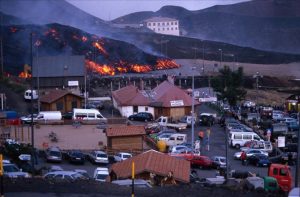
Fig. 2 Lava flow near a provincial road, a few meters from hotels and souvenir shops, during the 2001 lateral eruption at Etna. Credit: Mario Cipollini
Therefore, it is of primary importance to evaluate the conditions that control dike propagation and/or arrest to try to better evaluate, and eventually reduce, the dike-induced volcanic risk. Our knowledge of magmatic systems is usually limited to surface observations, thus models are useful tools to better understand geological processes that cannot be observed directly. In particular, analogue modelling allows simulating natural processes using scaled materials that reproduce the rheological behavior (i.e ductile or brittle) of crust and mantle. In structural geology and tectonics analogue modelling is often used to understand the nature and mechanism of geological processes in a reasonable spatial and temporal scale.
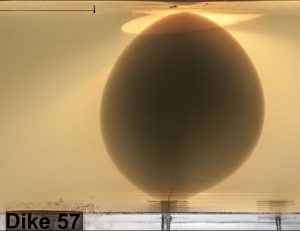 Field evidence and theoretical models indicate that the direction of dike propagation is controlled by many factors including magma buoyancy and topographic loads. The relative weight of these factors in affecting vertical and lateral propagation of dikes is still unclear and poorly understood. My PhD project focuses on investigating the controlling factors on dike propagation by establishing a hierarchy among them and discriminating the conditions favoring vertical or lateral propagation of magma through dikes. I am applying my results to selected natural cases, like Bardarbunga (Iceland) and Etna (Italy). To achieve this goal, I performed analogue experiments on dike intrusion by injecting dyed water in a plexiglass box filled with pig-skin gelatin. The dyed water and the gelatin act as analogues for the magma and the crust, respectively. Pig-skin gelatin has been commonly used in the past to simulate the brittle crust, since at the high strain rates due to dike emplacement it shows brittle-elastic properties representative of the Earth’s crust. We record all the experiments with several cameras positioned at different angles, taking pictures every 10 seconds. This allows us to make a 3D reconstruction of the dike propagation during the experiment.
Field evidence and theoretical models indicate that the direction of dike propagation is controlled by many factors including magma buoyancy and topographic loads. The relative weight of these factors in affecting vertical and lateral propagation of dikes is still unclear and poorly understood. My PhD project focuses on investigating the controlling factors on dike propagation by establishing a hierarchy among them and discriminating the conditions favoring vertical or lateral propagation of magma through dikes. I am applying my results to selected natural cases, like Bardarbunga (Iceland) and Etna (Italy). To achieve this goal, I performed analogue experiments on dike intrusion by injecting dyed water in a plexiglass box filled with pig-skin gelatin. The dyed water and the gelatin act as analogues for the magma and the crust, respectively. Pig-skin gelatin has been commonly used in the past to simulate the brittle crust, since at the high strain rates due to dike emplacement it shows brittle-elastic properties representative of the Earth’s crust. We record all the experiments with several cameras positioned at different angles, taking pictures every 10 seconds. This allows us to make a 3D reconstruction of the dike propagation during the experiment.
In order to have a complete understanding of the dike intrusion process it is essential to compare the laboratory results with natural examples. Hence, we went to the field and studied dikes outcropping in extinct and eroded volcanic areas, with the aim of reconstructing the magma flow direction (Fig. 3). This allows validating and interpreting correctly the observations made during the laboratory simulations of the natural process that we are investigating.

Fig. 3 Outcrop of dikes intruding lava flows. Berufjordur eastern Iceland.

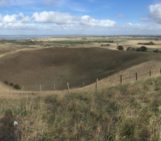
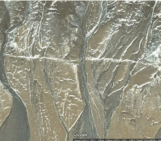
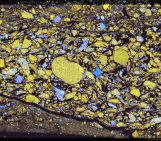

Pingback: GeoLog | Looking back at the EGU Blogs in 2016: a competition